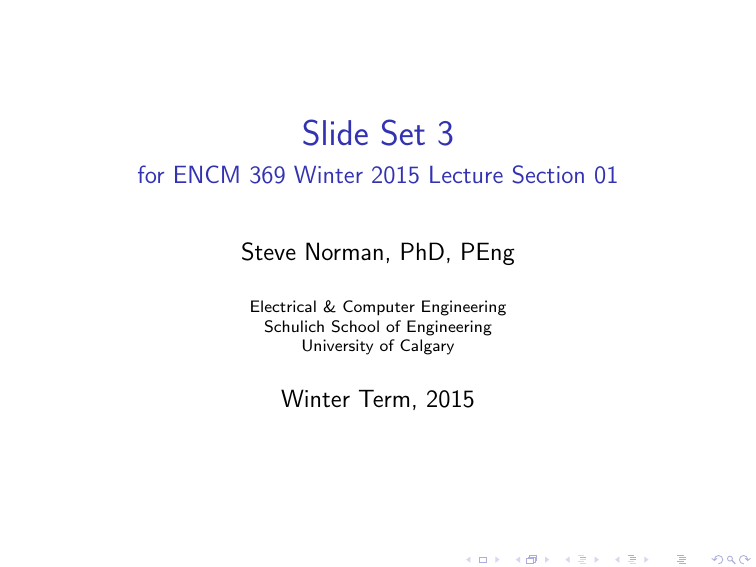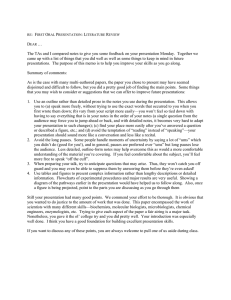Slide Set 3 - for ENCM 369 Winter 2015 Lecture Section 01
advertisement

Slide Set 3
for ENCM 369 Winter 2015 Lecture Section 01
Steve Norman, PhD, PEng
Electrical & Computer Engineering
Schulich School of Engineering
University of Calgary
Winter Term, 2015
ENCM 369 W15 Section 01 Slide Set 3
Contents
Review of the ASCII character set
Bytes Within Memory Words in MIPS
Byte loads and stores in MIPS: lb, lbu, and sb
A Complex Stack Frame Example
Logical Instructions
slide 2/39
ENCM 369 W15 Section 01 Slide Set 3
Outline of Slide Set 3
Review of the ASCII character set
Bytes Within Memory Words in MIPS
Byte loads and stores in MIPS: lb, lbu, and sb
A Complex Stack Frame Example
Logical Instructions
slide 3/39
ENCM 369 W15 Section 01 Slide Set 3
slide 4/39
Review of the ASCII character set
Text in English can be represented using ASCII codes, which
range from 0 to 127.
Example ASCII codes . . .
character
\0
\n
A
a
3
ASCII code
0
10
65
97
51
ENCM 369 W15 Section 01 Slide Set 3
slide 5/39
How much memory for one ASCII code?
Smallest ASCII code in base two: 0000 0000
Largest ASCII code in base two: 0111 1111.
So, a single byte (8 bits) is more than large enough to hold
any possible ASCII code.
Typically, ASCII character strings are stored in memory in
arrays of bytes and in file systems as sequences of bytes.
ENCM 369 W15 Section 01 Slide Set 3
Outline of Slide Set 3
Review of the ASCII character set
Bytes Within Memory Words in MIPS
Byte loads and stores in MIPS: lb, lbu, and sb
A Complex Stack Frame Example
Logical Instructions
slide 6/39
ENCM 369 W15 Section 01 Slide Set 3
slide 7/39
Bytes Within Memory Words in MIPS
We’ve already seen that each memory word can also be used
as a group of four bytes with consecutive addresses.
For example, consider the two words with addresses
0x1001 0000 and 0x1001 0004. What are the addresses of the
bytes in these words?
What would be the maximum length of a C character string
stored in those bytes?
ENCM 369 W15 Section 01 Slide Set 3
slide 8/39
Preview of MIPS sb, lb, and lbu instructions
The MIPS sb instruction writes a single byte within a 4-byte
memory word, leaving the other 3 bytes unchanged.
The MIPS lb and lbu instructions both read a single byte
from within a 4-byte memory word. (We’ll look at the
difference between lb and lbu a bit later on.)
Before studying these instructions in detail, let’s look at the
relationship between a byte in memory and the memory word
that contains the byte.
ENCM 369 W15 Section 01 Slide Set 3
slide 9/39
Bit numbering within an n-bit pattern
Here is the most usual and most convenient way to do this:
I the number of the MSB (most significant bit) is n − 1;
I the number of the LSB (least significant bit) is 0.
A general n-bit pattern is then bn−1 bn−2 · · · b2 b1 b0 , where
each bi is either 0 or 1.
One reason why this is convenient is that it gives a natural,
simple formula for the unsigned integer the bit pattern
represents:
bn−1 × 2n−1 + bn−2 × 2n−2 + . . .
+ b2 × 22 + b1 × 21 + b0 × 20 .
(The formula for the signed two’s-complement integer the
bit pattern represents is almost as simple, as we’ll see later in
the course.)
slide 10/39
ENCM 369 W15 Section 01 Slide Set 3
Bit numbering: examples
Machine code for MIPS instruction addi $17, $16, 4 . . .
31
26 25
21 20
16 15
0
00100010000100010000000000000100
A byte containing the ASCII code for ’A’, which is
65ten = 0x41 = 01000001two .
7 6 5 4 3 2 1 0
01000001
ENCM 369 W15 Section 01 Slide Set 3
slide 11/39
Bit numbering, continued
What you will always see in this course, in lectures, tutorials,
labs and the textbook:
I Bit n − 1 is the MSB; bit 0 is the LSB.
What you will see in most current “real world” computer
system documentation:
I Bit n − 1 is the MSB; bit 0 is the LSB. (Same as in this
course.)
Alternate schemes you might encounter:
I Bit 0 is the MSB; bit n − 1 is the LSB.
I Bit n is the MSB; bit 1 is the LSB.
I Bit 1 is the MSB; bit n is the LSB.
slide 12/39
ENCM 369 W15 Section 01 Slide Set 3
Little-endian organization of bytes within words
Little-endian is the name given to this way of addressing bytes
within a word:
numbers for bits within the word
31
...
24 23
7
...
07
+3
...
...
16 15
...
87
...
0
07
...
07
...
0
+2
+1
+0
address offsets of bytes
numbers for bits within bytes
MARS has little-endian memory organization. So do some
very important architectures, such as x86 and x86-64.
There is another widely-used organization called big-endian;
we’ll study that much later in the course.
ENCM 369 W15 Section 01 Slide Set 3
slide 13/39
Bytes within words in MARS: a demonstration
Use the editor to set up two
strings of length 3. (So,
4 bytes per string.)
Use
Use
to assemble the code. Data Segment display is . . .
to show the actual characters . . .
ENCM 369 W15 Section 01 Slide Set 3
slide 14/39
Example: External arrays of bytes and words
Two C arrays defined outside of function definitions . . .
char foo[ ] = "hello";
int bar[ ] = { -10, 20, 30 };
One way to write MARS A.L. to set up these two arrays . . .
.data
.globl foo
foo: .byte ’h’, ’e’, ’l’, ’l’, ’o’, ’\0’
.globl bar
bar: .word -10, 20, -30
Note: .byte was used just to show its similarity to .word. It’s
normally more convenient to use .asciiz for strings.
slide 15/39
ENCM 369 W15 Section 01 Slide Set 3
Layout of foo and bar within the data segment
Fragment of data segment used for foo and bar ...
higher
addresses
Why are these
two bytes
not used?
’l’
-30
20
-10
’\0’ ’o’
’l’
’e’ ’h’
bar[2]
bar[1]
bar[0]
foo[4]
foo[0]
Access to elements of bar will be with lw and sw instructions,
but access to elements of foo will use lb (or lbu) and sb.
ENCM 369 W15 Section 01 Slide Set 3
slide 16/39
Contents of foo and bar as 1’s and 0’s instead of
symbols like ’h’ and -10
Fragment of data segment used for foo and bar ...
higher
addresses
11111111 11111111 11111111 11100010
00000000 00000000 00000000 00010100
11111111 11111111 11111111 11110110
00000000 00000000 00000000 01101111
01101100 01101100 01100101 01101000
bar[2]
bar[1]
bar[0]
foo[4]
foo[0]
Of course, when the program runs, the 1’s and 0’s are high
and low voltages at various nodes in a memory circuit.
ENCM 369 W15 Section 01 Slide Set 3
Outline of Slide Set 3
Review of the ASCII character set
Bytes Within Memory Words in MIPS
Byte loads and stores in MIPS: lb, lbu, and sb
A Complex Stack Frame Example
Logical Instructions
slide 17/39
ENCM 369 W15 Section 01 Slide Set 3
slide 18/39
Byte loads and stores in MIPS: lb, lbu, and sb
instructions
lb and lbu: Both copy a byte from memory into bits 7–0 of a
GPR. There is a difference in what happens to bits 31–8 of the
GPR—let’s illustrate that with a picture.
sb copies bits 7–0 from a GPR to a memory byte. Bits 31–8
of the GPR are ignored.
ENCM 369 W15 Section 01 Slide Set 3
slide 19/39
lb and lbu: examples
Suppose that
I $s0 contains 0x1001 0009;
I the value of the byte at address 0x1001 0009 is 0x99;
I the value of the byte at address 0x1001 000a is 0x7e.
What values will $t0–$t3 get?
lb
lbu
lb
lbu
$t0,
$t1,
$t2,
$t3,
0($s0)
0($s0)
1($s0)
1($s0)
ENCM 369 W15 Section 01 Slide Set 3
sb: examples
Suppose that
I $s1 contains 0x1001 0020;
I $t0 contains 0x1234 5678.
What will these instructions do?
sb
sb
$t0, ($s1)
$t0, 1($s1)
slide 20/39
ENCM 369 W15 Section 01 Slide Set 3
slide 21/39
Which to use: lb or lbu?
If you know that the byte being read is an ASCII code, it
doesn’t matter—bit 7 of the byte will be 0, so lb and lbu have
the same effect.
An example on page 324 of the textbook uses lb, but would
work equally well if lbu were used instead.
Examples in ENCM 369 lectures, labs, and tutorials will use
lbu, to be consistent with examples used in the course over
the last few years.
ENCM 369 W15 Section 01 Slide Set 3
slide 22/39
Why do lb and lbu both exist? (part 1)
Sometimes arrays of bytes are used not for character codes but
for collections of integers with small magnitudes.
We’re NOT going to go into detail right now.
The difference between lb and lbu has to do with rules for
converting 8-bit integers into 32-bit integers with either
sign-extension for signed numbers or zero-extension for
unsigned numbers.
ENCM 369 W15 Section 01 Slide Set 3
slide 23/39
Why do lb and lbu both exist? (part 2)
lb “does the right thing” when an array of bytes is used as a
collection of signed char numbers with values from the set
{−128, −127, . . . , −1, 0, 1, . . . , 126, 127}.
lbu “does the right thing” when an array of bytes is used as a
collection of unsigned char numbers with values from the
set {0, 1, 2, . . . , 253, 254, 255}.
For more about signed and unsigned number systems, see
textbook Section 1.4 (which was covered early in ENEL 353 in
Fall 2014) and lectures in future weeks.
slide 24/39
ENCM 369 W15 Section 01 Slide Set 3
Byte access programming example
void my_strcpy(char *dest,
const char *src)
{
while (*src != ’\0’) {
*dest = *src;
dest++;
src++;
}
*dest = ’\0’;
}
This is like the
strcpy function in
the standard C
library, except that
my_strcpy does not
return a value.
Let’s write a MIPS
A.L. translation for
my_strcpy.
ENCM 369 W15 Section 01 Slide Set 3
slide 25/39
Mixing word and byte accesses to memory
Usually,
I data written as bytes is later read back as bytes;
I data written as words is later read back as words.
However, studying code that mixes access types helps to check
whether you understand exactly how byte addressing works.
Suppose that $s0 contains 0x1001 0000. What will $t2
contain after these instructions are executed . . . ?
addi
addi
sw
sb
sb
lw
$t0, $zero, 0xab
$t1, $zero, 0xcd
$zero, 4($s0)
$t0, 7($s0)
$t1, 5($s0)
$t2, 4($s0)
ENCM 369 W15 Section 01 Slide Set 3
Outline of Slide Set 3
Review of the ASCII character set
Bytes Within Memory Words in MIPS
Byte loads and stores in MIPS: lb, lbu, and sb
A Complex Stack Frame Example
Logical Instructions
slide 26/39
ENCM 369 W15 Section 01 Slide Set 3
A complex stack frame example
int g(char *p, int n);
int h(int *q, int j, int k);
int f(void)
{
int a, b;
char x[5];
int y[4];
a = g(x, 5);
b = h(y, 4, a);
// MORE CODE: uses a, b, &b,
// x, y, but NEVER &a.
return b;
}
slide 27/39
ENCM 369 W15 Section 01 Slide Set 3
slide 28/39
Complex stack frame example: Questions
I
I
I
I
I
How to allocate a, b, x, and y?
What are the stack frame needs for f?
What will be the layout of the stack frame?
What will be the A.L. code for a = g(x, 5); ?
What will be the A.L. code for b = h(y, 4, a); ?
Attention: The lecture will skip writing the prologue and
epilogue for f. Make sure you know what code would be
needed!
ENCM 369 W15 Section 01 Slide Set 3
Outline of Slide Set 3
Review of the ASCII character set
Bytes Within Memory Words in MIPS
Byte loads and stores in MIPS: lb, lbu, and sb
A Complex Stack Frame Example
Logical Instructions
slide 29/39
ENCM 369 W15 Section 01 Slide Set 3
slide 30/39
Logical Instructions—Textbook Section 6.4.1
sll: shift left, logical (already seen)
srl: shift right, logical
or, ori: bitwise OR (“bitwise” means “operate on multiple
pairs of input bits in parallel”)
lui: copy 16-bit constant into bits 31–16 of GPR
and, andi: bitwise AND
nor: bitwise NOR
xor, xori: bitwise XOR
ENCM 369 W15 Section 01 Slide Set 3
srl: shift right, logical
srl is like sll, but shifts right instead of left.
Example: Suppose $t0 = 24 zeros 0101 0111.
Then what does srl $t1, $t0, 3 put in $t1?
slide 31/39
slide 32/39
ENCM 369 W15 Section 01 Slide Set 3
or, ori
OR truth table for one pair of input bits:
x
0
0
1
1
y
0
1
0
1
OR(x, y )
0
1
1
1
MIPS or and ori instructions do 32 simultaneous OR
operations on 32 pairs of bits.
ENCM 369 W15 Section 01 Slide Set 3
Logical instructions: or example
or $t2, $t0, $t1 . . .
Suppose $t0 contains 1101_[24 zeros]_0011 and
$t1 contains 0001_[24 zeros]_0101.
The result, which goes into $t2, is . . . ?
slide 33/39
ENCM 369 W15 Section 01 Slide Set 3
slide 34/39
Logical instructions: or vs. add
Attention: bitwise OR is not addition!
The OR of 1 and 1 is 1. The arithmetic SUM of 1 and 1 is 0,
with a CARRY of 1.
Previous example, with or changed to add . . .
$t0 contents . . . 1101_[24 zeros]_0011
$t1 contents . . . 0001_[24 zeros]_0101
result, goes to $t2 . . . 1110_[24 zeros]_1000
The add result is not the same as the or result!
ENCM 369 W15 Section 01 Slide Set 3
slide 35/39
Logical instructions: ori
ori: one source is a GPR, the other is a constant.
Example: ori $t4, $t3, 0x895a
Suppose $t3 contains 0xab00_0034. What value does $t4
get?
ENCM 369 W15 Section 01 Slide Set 3
slide 36/39
Logical instructions: lui
lui: load upper immediate
This copies a constant into bits 31–16 of a GPR, and makes
bits 15–0 of the GPR zero.
Example: lui $t0, 0xf7b3
What value does $t0 get?
ENCM 369 W15 Section 01 Slide Set 3
slide 37/39
lui and big constants
Suppose i is an int in $s0. What would the instruction(s) be
for this?
i = 0x49b1_ae09;
The constant is too big to embed in a single instruction, so
the job gets split into two instructions:
lui
$s0, 0x49b1
# update bits 31-16
ori
$s0, $s0, 0xae09 # update bits 15-0
What is in $s0 after lui ? After ori ?
ENCM 369 W15 Section 01 Slide Set 3
slide 38/39
lui, ori, li, la
li is a MIPS pseudoinstruction for getting a large constant into
a GPR. Example:
li
$s0, 0x49b1ae09
gets translated into what we just saw . . .
lui
$s0, 0x49b1
ori
$s0, $s0, 0xae09
The assembler handles pseudoinstructions of the form
la
GPR , label
in a similar way.
ENCM 369 W15 Section 01 Slide Set 3
slide 39/39
Logical instructions: and, andi, nor, xor, xori
These are easy to understand if you understand or and ori.
Read Section 6.4.1 of the textbook for details and examples.


